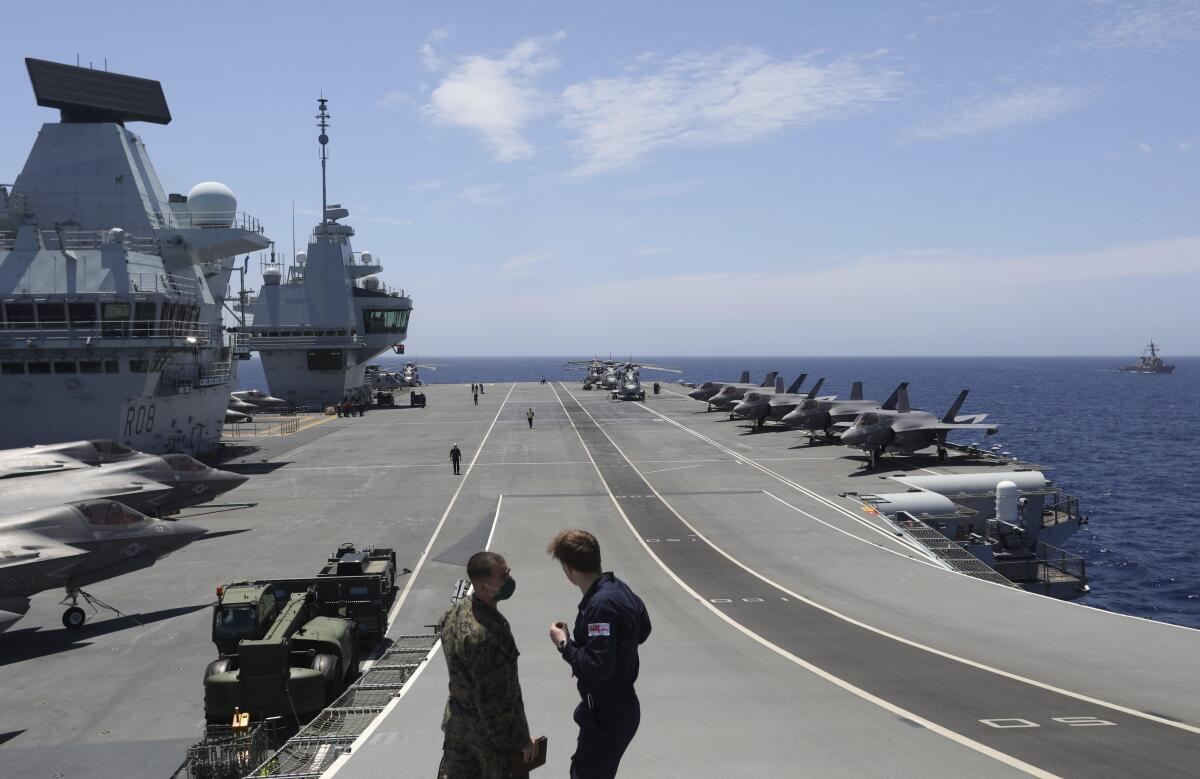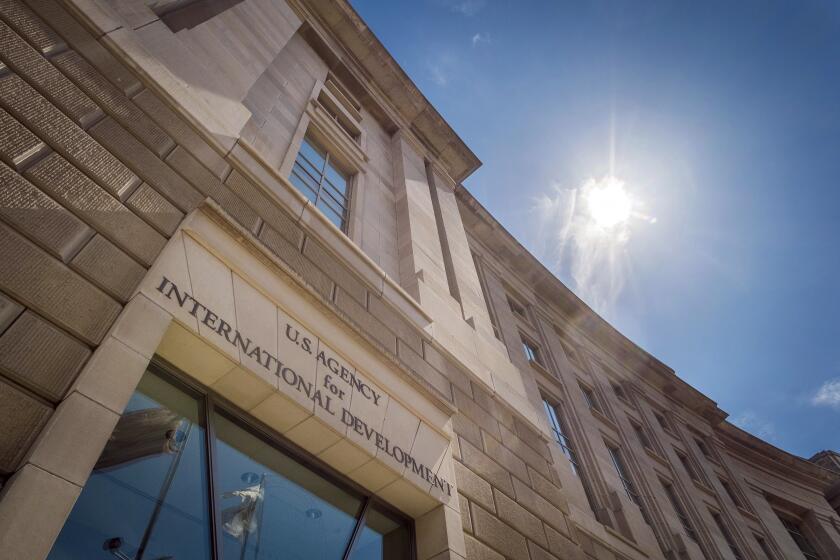NATO conducts massive war games amid simmering tensions with Russia

- Share via
ABOARD HMS QUEEN ELIZABETH — As tensions with Russia simmer, thousands of NATO troops, several warships and dozens of aircraft are taking part in military exercises stretching across the Atlantic, through Europe and into the Black Sea region.
The war games, dubbed Steadfast Defender 21, are aimed at simulating the 30-nation military alliance’s response to an attack on any one of its members. The exercises will test NATO’s ability to deploy troops from the U.S. and keep supply lines open.
Already in recent years, the United States and its allies have deployed troops and equipment in Estonia, Latvia, Lithuania and Poland, which all abut Russian territory, to try to reassure them that their NATO partners will ride to the rescue should they come under attack.
Moscow’s decision last month to send thousands of troops to the border area with Ukraine has raised concern at NATO, which launched one of its biggest-ever defense spending initiatives after Russian troops annexed Ukraine’s Crimean Peninsula in 2014.
Top NATO brass insist that the military exercises, involving some 9,000 troops from 20 nations, are not aimed at Russia specifically, but they focus on the Black Sea region, where Russia is accused of blocking the free navigation of ships.
NATO Secretary-General Jens Stoltenberg says the exercises send an important message to any potential adversary: “NATO is ready.”
Microsoft says Russian-backed SolarWinds hackers launched a targeted spear-phishing assault on U.S. and foreign government agencies and think tanks.
“NATO is there to defend all our allies, and this exercise sends a message about our ability to transport a large number of troops, equipment across the Atlantic, across Europe and also to project maritime power,” Stoltenberg told the Associated Press aboard a British aircraft carrier off the coast of Portugal.
The ship, the HMS Queen Elizabeth, is the pride of the British Navy. It’s making its maiden voyage and carrying 18 F-35 jets, in the first deployment of so many of the fifth-generation warplanes aboard an aircraft carrier.
The ship’s presence, part of a six- to seven-month deployment that will take the vessel south past India, through Southeast Asia to the Philippines Sea, is aimed in part at restoring Britain’s tarnished image as a major global power since it left the European Union.
Adorned with high-tech U.S. jets and flanked by warships from other NATO countries, the carrier strike force is also meant to serve as an important symbol of unity as the world’s biggest security organization tries to recover from the four tumultuous years of the Trump administration.
Breaking News
Get breaking news, investigations, analysis and more signature journalism from the Los Angeles Times in your inbox.
You may occasionally receive promotional content from the Los Angeles Times.
Stoltenberg will chair a June 14 NATO summit in Brussels with President Biden and his counterparts in hopes of ushering in a new era of transatlantic cooperation as NATO troops leave Afghanistan — the alliance’s longest-ever mission — while tensions with Russia and, increasingly, China mount.
The war games tie in two new NATO command centers, one in Norfolk, Va., and the other in Ulm, Germany. Part of the focus of its first phase was to protect the undersea cables that carry masses of commercial and communications data between the U.S. and Europe.
NATO says Russia is mapping the cables’ routing and might have darker intentions.
“We all lulled ourselves into thinking that the Atlantic was a benign region in which there was not anything bad going on, and we could just use it as a free highway,” the Norfolk center’s commander, U.S. Navy Vice-Admiral Andrew Lewis, said.
As U.S. forces pull out from Afghanistan, the Taliban is in the ascendant — and threatening to retake the city that was its former spiritual capital.
“There are nations are out there mapping those cables. They may be doing something else bad. We have to be aware of that and answer that,” he told reporters.
NATO says its policy toward Russia is based on two pillars: strong military deterrence and dialogue. But high-level meetings between the two historic foes are rare, and European officials insist that Russian President Vladimir Putin is turning increasingly authoritarian and distancing himself from the West.
“We’re ready to sit down with Russia, because we think it’s important to talk, especially when times are difficult,” Stoltenberg said. “The main challenge now is that Russia has not responded positively to our invitation, or our initiative, for a meeting of the NATO-Russia Council,” their top consultative forum.
More to Read
Sign up for Essential California
The most important California stories and recommendations in your inbox every morning.
You may occasionally receive promotional content from the Los Angeles Times.












